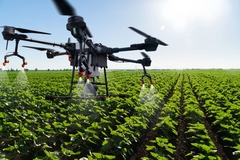Coffee concerns: Volatile supplies, extreme weather and soaring prices weigh heavy on the sector
06 Aug 2024 --- Coffee prices have been blighted by extreme market volatility, impacting prices, supply chains and livelihoods across the world.
When coffee giant Lavazza’s chairman recently shared that coffee prices were likely to remain “very high” until at least the middle of next year, it highlighted how extreme these levels of unpredictability are.
The reasons Giuseppe Lavazza outlined were logical. Adverse effects and unstable market conditions have put coffee supply chains under increasing pressure. The price surge also sits against a backdrop of fears over inventory shortages, while the drink remains one of the world’s most popular beverages.
Brits consume around 100 million cups of coffee every day, while 67% of American adults drink more coffee daily than any other beverage, including tap or bottled water.

This makes the supply and demand balancing act a fragile one.
Coffee prices have been peaking since the COVID-19 pandemic, owing to unseasonal weather conditions, growing popularity among Millennials living in cities and labor shortages. While most similar commodities returned closer to normal market levels (with the exception of cacao, which faces similar challenges), the cost of coffee has continued to rise rapidly.
Climatic disruptions
According to figures from the Fairtrade Foundation, coffee prices have experienced unprecedented volatility. It went from a price of US$1.80/lb in February to a high of US$2.45/lb in April, an increase of 65 cents per pound, then going back down to US$2.25/lb, a decrease of 20 cents per pound, in just a week.
A spokesperson for the foundation tells Food Ingredients First: “Adverse weather conditions in major coffee-producing countries, particularly in Southeast Asia and Brazil, have led to fears of shortages, exacerbating the already delicate balance of supply and demand.”
“Prolonged heat waves in Vietnam, a key producer of robusta beans, have damaged crops, while Brazil, the world’s largest producer of Arabica beans, has faced challenges from heavy rainfall impacting its harvests.”
 Increases in labor costs to compensate for coffee are contributing to higher end prices.
Increases in labor costs to compensate for coffee are contributing to higher end prices.
They add that these climatic disruptions, compounded by geopolitical tensions disrupting shipping routes and the speculative nature of futures contracts across investment portfolios, have created a perfect storm of uncertainty in the coffee market.
“Pricing up”
High prices can also be partly attributed to “pricing up,” an age-old tactic that happens at various levels of the supply chain across many other product categories than just coffee, ensuring companies can increase their profit margins.
Gerard Rijk, senior equity analyst at research organization Profundo, tells Food Ingredients First that post-COVID, labor issues play a significant part in how the market is performing.
“There is an increase in labor costs to compensate for inflation when it comes to coffee, leading to higher-end prices,” he explains.
“Coffee is served in cafes and restaurants, not just homes, so the labor aspect plays a big role. The one bringing your coffee to your table earns 10% more than they did three years ago. So that’s also increasing the prices of coffee at the endpoint for the consumer,” adds Rijk.
On the consumer side, 1kg of coffee can cost anywhere from €7 (US$8) to €8 (US$9) for low-end produce and up to €30 (US$33) or more for higher-end products.
Decisions on pricing
According to the British Coffee Association, recent trends have seen an increase in the consumption of specialty coffees, which tend to be in a higher price bracket.
Thomas de Freitas, spokesperson for the British Coffee Association, tells Food Ingredients First that as well as weather conditions, rises in the global price of energy and, often for high-street cafes, the availability and cost of employees also impact the industry.
He says: “These factors, as well as any costs associated with new rules and regulations, are always under constant review by businesses as they make decisions on pricing.”
 Vietnam is a key producer of Robusta beans, which have been impacted by tough climate conditions.
Vietnam is a key producer of Robusta beans, which have been impacted by tough climate conditions.
He adds that coffee businesses are focusing on longer-term support for coffee producers, many of whom will face climate change-related challenges that could impact their future production.
“A part of the price paid by the final customer is used to make real and lasting positive change in coffee-producing communities worldwide,” says de Freitas.
Impact on coffee farmers
The coffee industry is notorious for being unforgiving to those at the coalface. Farmers’ ability to maintain a steady income often hinges on factors beyond human control, such as weather conditions and supply chain decisions, making it an unstable livelihood for many.
There are around 125 million people worldwide who depend on the produce to make a living, according to the Fairtrade Foundation. These farmers often experience price volatility which has significant consequences. It makes it difficult for growers to predict their income for the coming season and budget for their household and farming needs.
The coffee supply chain is complex as beans pass through the hands of growers, traders, processors, exporters, roasters and retailers until they finally reach the consumer. While higher coffee prices may seem beneficial for coffee farmers, this is often not the reality.
 Around 125 million people worldwide depend on the produce to make a living.
Around 125 million people worldwide depend on the produce to make a living.
“In fact, the sudden surges and drops in coffee prices can cause significant strain and hardship for farmer organizations. If prices soar, after a contract price has been fixed, the cooperative may still need to purchase coffee at prices competitive with what local buyers and middlemen are offering, and that could be far beyond what the contract will compensate for,” the Fairtrade Foundation spokesperson explains.
“But if the cooperative is unable to bring in sufficient coffee from its members, due to the intense local competition that invariably accompanies high price moments, it risks significant fines and reputational damage that comes with contract defaults.”
No one entity is responsible for ensuring farmers get protection from market headwinds. Big corporations, policymakers, not-for-profits and consumers all have a role in prioritizing the well-being of smallholders. Accountability remains hazy.
However, one thing is clear. With the world’s love affair for coffee showing no signs of abating and supply chains being squeezed to their limit, the drink’s high prices are, for now at least, here to stay.
By Sade Laja











